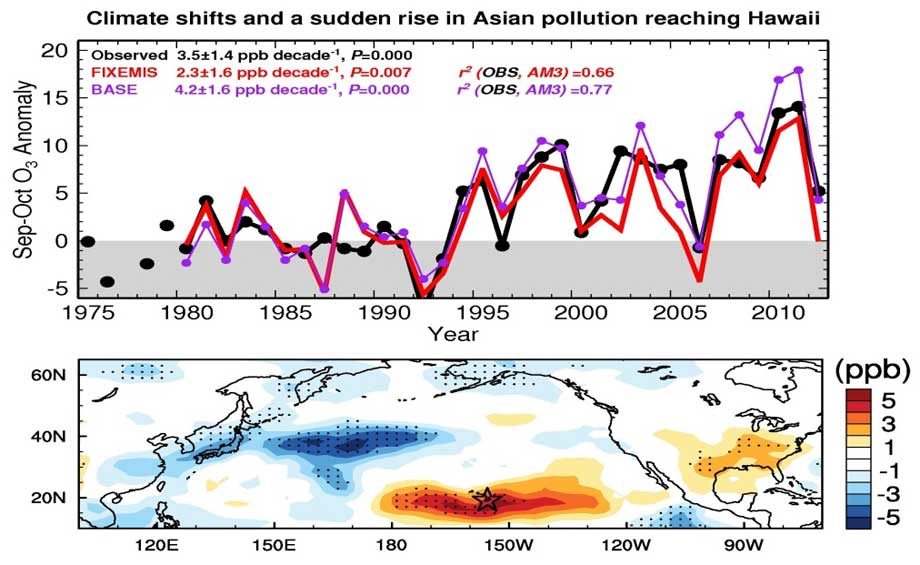February 6th, 2014
Key Findings
- Climate shifts have caused Asian ozone pollution reaching Hawaii to rise unexpectedly in autumn since mid-1990s.
- The flow of ozone-rich air from Eurasia towards Hawaii during spring weakened in the 2000s as a result of La-Niña-like decadal cooling in the equatorial Pacific.
- During autumn, stronger transport of Asian pollution to Hawaii since the mid-1990s corresponds to a positive pattern of atmospheric circulation variability known as the Pacific-North American pattern.
Meiyun Lin, Larry W. Horowitz, Samuel J. Oltmans, Arlene M. Fiore, Songmiao Fan. Tropospheric ozone trends at Mauna Loa Observatory tied to decadal climate variability. Journal: Nature Geoscience. DOI:10.1038/NGEO2066
Summary
A potent greenhouse gas and biological irritant, ozone near the Earth surface is also a health-damaging air pollutant, regulated by the U.S. Environmental Protection Agency. Shifts in atmospheric circulation have caused Asian ozone pollution reaching Hawaii to rise unexpectedly in autumn since mid-1990s, according to this study. The findings, published in Nature Geoscience, imply that decade-long variability in climate must be considered when attributing observed ozone changes to human-induced trends in precursor emissions.
The longest record of ozone in the U.S. goes back to 1973 in Hawaii. Ozone might be expected to increase in spring due to powerful springtime winds and tripling emissions from Asia since 1980s. The 40-year Hawaiian record, however, has shown little change in spring, yet an increase in autumn. This research helps to solve this puzzle. Changing wind patterns “hide” the increase in pollution from Asia in the spring, but amplify the change in the autumn.
The authors further identified the different mechanisms driving the seasonal changes in atmospheric circulation patterns. They show that the flow of ozone-rich air, from Eurasia towards Hawaii during spring, weakened in the 2000s as a result of La-Niña-like decadal cooling in the equatorial Pacific. During autumn, stronger transport of Asian pollution to Hawaii since the mid-1990s corresponds to a positive pattern of atmospheric circulation variability known as the Pacific-North American pattern. Characterizing shifts in atmospheric circulation patterns is of paramount importance for advancing knowledge on the response of ozone levels near the Earth surface to changing climate and evolving global emissions.



